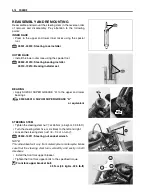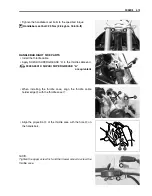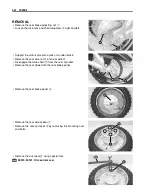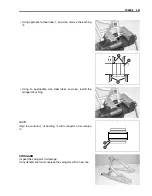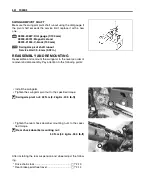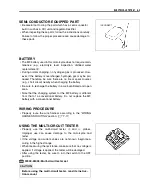
6-2 ELECTRICAL SYSTEM
CAUTIONS IN SERVICING
CONNECTOR
• When connecting a connector, be sure to push it in until a
click is felt.
• Inspect the connector for corrosion, contamination and break-
age in its cover.
COUPLER
• With a lock type coupler, be sure to release the lock when dis-
connecting, and push in fully to engage the lock when con-
necting.
• When disconnecting the coupler, be sure to hold the coupler
itself and do not pull the lead wires.
• Inspect each terminal on the coupler for being looseness or
bending.
• Inspect each terminal for corrosion and contamination.
• Push in the coupler straightly. An angled or skewed insertion
may cause the terminal to be deformed, possibly resulting in
poor electrical contact.
• Before refitting the sealed coupler, make sure seal rubber is
positioned properly. The seal rubber may possibly come off
the position during disconnecting work and if the coupler is
refitted with the seal rubber improperly positioned, it may
result in poor water sealing.
CLAMP
• Clamp the wire harness at such positions as indicated in
“WIRING HARNESS ROUTING”. (
7-11)
• Bend the clamp properly so that the wire harness is clamped
securely.
• In clamping the wire harness, use care not to allow it to hang
down.
• Do not use wire or any other substitute for the band type
clamp.
FUSE
• When a fuse blows, always investigate the cause to correct it
and then replace the fuse.
• Do not use a fuse of a different capacity.
• Do not use wire or any other substitute for the fuse.
Click
Click
CORRECT
INCORRECT

